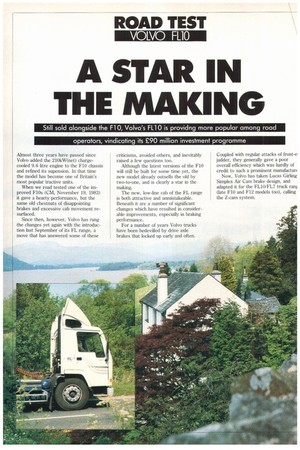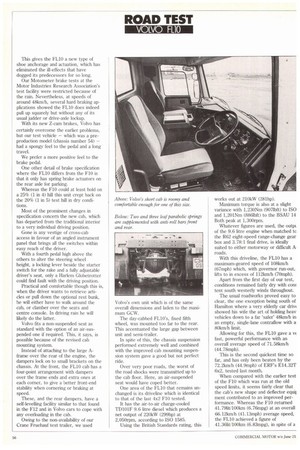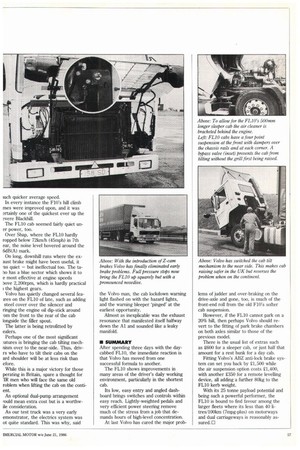A STAR IN THE NIAICING
Page 54

Page 56

Page 57

If you've noticed an error in this article please click here to report it so we can fix it.
Still sold alongside the F10, Volvo's FM0 is providng more popular among road operators, vindicating its £90 million investment programme
Almost three years have passed since Volvo added the 210kW(net) chargecooled 9.6 litre engine to the FIO chassis and refined its supension. In that time the model has become one of Britain's most popular tractive units.
When we road tested one of the improved FlOs (CM, November 19, 1983) it gave a hearty performance, but the same old chestnuts of disappointing brakes and excessive cab movement resurfaced.
Since then, however, Volvo has rung the changes yet again with the introduction last September of its FL range, a move that has answered some of these criticisms, avoided others, and inevitably raised a few questions too.
Although the latest versions of the FIO will still be built for some time yet, the new model already outsells the old by two-to-one, and is clearly a star in the making.
The new, low-line cab of the FL range is both attractive and unmistakeable. Beneath it are a number of significant changes which have resulted in considerable improvements, especially in braking performance.
For a number of years Volvo trucks have been bedevilled by drive axle brakes that locked up early and often. Coupled with regular attacks of front-e judder, they generally gave a poor overall efficiency which was hardly of credit to such a prominent manufacturf Now, Volvo has taken Lucas Girling Simplex Air Cam brake design, and adapted it for the FL10/FL7 truck ranl (late F10 and F12 models too), calling the Z-cam system. This gives the FLIO a new type of shoe anchorage and actuation, which has eliminated the ill-effects that have dogged its predecessors for so long.
Our Motometer brake tests at the Motor Industries Research Association's test facility were restricted because of the rain. Nevertheless, at speeds of around 48km/h, several hard braking applications showed the FL10 does indeed pull up squarely but without any of its usual judder or drive-axle lockup.
With its new Z-cam brakes, Volvo has certainly overcome the earlier problems, but our test vehicle — which was a preproduction model (chassis number 54) — had a spongy feel to the pedal and a long travel.
We prefer a more positive feel to the brake pedal.
One other detail of brake specification where the FL10 differs from the F10 is that it only has spring brake actuators on the rear axle for parking.
Whereas the F10 could at least hold on a 25% (1 in 4) hill this unit crept back on the 20% (1 in 5) test hill in dry conditions.
Most of the prominent changes in specification concern the new cab, which has departed from the traditional interior to a very individual driving position.
Gone is any vestige of cross-cab access in favour of an angled instrument panel that brings all the switches within easy reach of the driver.
With a fourth pedal high above the others to alter the steering wheel height, a locking lever beside the starter switch for the rake and a fully adjustable driver's seat, only a Harlem Globetrotter could find fault with the driving position.
Practical and comfortable though this is, when the driver wants to retrieve articles or pull down the optional rest bunk, he will either have to walk around the cab, or clamber over the seats and centre console. In driving rain he will Likely do the latter.
Volvo fits a non-suspended seat as standard with the option of an air-suspended one if required. This, it says, is possible because of the revised cab mounting system.
Instead of attaching to the large Aframe over the rear of the engine, the dampers lock on to small brackets on the chassis. At the front, the FL10 cab has a four-point arrangement with dampers over the frame ends and extra ones at each corner, to give a better front-end stability when cornering or braking at speed.
These, and the rear dampers, have a self-levelling facility similar to that found in the F12 and in Volvo cars to cope with any overloading in the cab.
Owing to the non-availability of our Crane Fruehauf test trailer, we used Volvo's own unit which is of the same overall dimensions and laden to the maximum GCW.
The day-cabbed FL10's, fixed fifth wheel, was mounted too far to the rear. This accentuated the large gap between unit and semi-trailer.
In spite of this, the chassis suspension performed extremely well and combined with the improved cab mounting suspension system gave a good but not perfect ride.
Over very poor roads, the worst of the road shocks were transmitted up to the cab floor. Here, an air-suspended seat would have coped better.
One area of the FL10 that remains unchanged is its driveline which is identical to that of the Last 4x2 F10 tested.
It has the air-to-air charge-cooled TD101F 9.6 litre diesel which produces a net output of 220kW (299hp) at 2,050rpm, according to ISO 1585.
Using the British Standards rating, this works out at 210kW (281hp).
Maximum torque is also at a slight variance with 1,230Nm (9071bft) to ISO and 1,201Nm (886Ibft) to the BSAU 14 Both peak at 1,300rpm.
Whatever figures are used, the outpt of the 9.6 litre engine when matched tc the R62 eight-speed range-change gear box and 3.78:1 final drive, is ideally suited to either motorway or difficult A. roads.
With this driveline, the FL10 has a maximum-geared speed of 108km/h (67mph) which, with governor run-out, lifts to in excess of 1121(m/h (70mph).
Apart from the first day of our test, conditions remained fairly dry with corm tent south westerly winds throughout.
The usual roadworks proved easy to clear, the one exception being south of Hamilton where a very elderly car driv( showed his wife the art of holding heav vehicles down to a far 'safer' 481cm/h in an empty, single-lane contraflow with a 80km/h limit.
Allowing for this, the FL10 gave a v( fast, powerful performance with an overall average speed of 71.581crrilli (44.78mph).
This is the second quickest time so far, and has only been beaten by the 72.21trn/h (44.9mph) of ERF's E14.32T 6x2, tested last month.
When compared with the earlier test of the F10 which was run at the old speed limits, it seems fairly clear that the cab's new shape and deflector equir ment contributed to an improved performance. Whereas the F10 returned 41.79k/100km (6.76mpg) at an overall 66.12km/h (41.13mph) average speed, the FL10 achieved a figure of 41.361it/100km (6.83mpg), in spite of a iuch quicker average speed.
In every instance the FM's hill climb mes were improved upon, and it was artainly one of the quickest ever up the avere Blackhill.
The FL10 cab seemed fairly quiet uner power, too.
Over Shap, where the FL10 hardly ropped below 721cm/h (45mph) in 7th ear, the noise level hovered around the 6dB(A) mark.
On long, downhill runs where the exaust brake might have been useful, it ras quiet — but ineffectual too. The taho has a blue sector which shows it to e most effective at engine speeds bove 2,200rprn, which is hardly practical i the highest gears.
Volvo has quietly changed several feaires on the FL10 of late, such as adding steel cover over the silencer and ringing the engine oil dip-stick around .om the front to the rear of the cab longside the filler spout.
The latter is being retrofitted by ealers.
Perhaps one of the most significant ;atures is bringing the cab tilting mechnism over to the near-side. Thus, drivrs who have to tilt their cabs on the ard shoulder will be at less risk than efore.
While this is a major victory for those perating in Britain, spare a thought for 'IR men who will face the same old roblem when lifting the cab on the contient An optional dual-pump arrangement rould mean extra cost but is a worthwile consideration.
As our test truck was a very early emonstrator, the electrics system was ot quite standard. This was why, said the Volvo man, the cab lockdown warning light flashed on with the hazard lights, and the warning bleeper `pinged' at the earliest opportunity.
Almost as inexplicable was the exhaust resonance that manifested itself halfway down the Al and sounded like a leaky manifold.
• SUMMARY After spending three days with the daycabbed FL10, the immediate reaction is that Volvo has moved from one successful formula to another.
The FLIO shows improvements in many areas of the driver's daily working environment, particularly in the shortest cab.
Its low, easy entry and angled dashboard brings switches and controls within easy reach. Lightly-weighted pedals and very efficient power steering remove much of the stress from a job that demands hours of high-level concentration.
At last Volvo has cured the major prob
lems of judder and over-braking on the drive-axle and gone, too, is much of the front-end roll from the old F10's softer cab suspension.
However, if the FL10 cannot park on a 20% hill, then perhaps Volvo should revert to the fitting of park brake chambers on both axles similar to those of the previous model.
There is the usual list of extras such as 2600 for a sleeper cab, or just half that amount for a rest bunk for a day cab.
Fitting Volvo's ABZ anti-lock brake system can set you back by 21,500 while the air suspension option costs 21,400, with another 250 for a remote levelling device, all adding a further 80kg to the FL10 kerb weight.
With its 25 tonne payload potential and being such a powerful performer, the FL10 is bound to find favour among the larger fleets where its less than 40 litres/100km (7mpg-plus) on motorways and dual carriageways is reasonably assured. 0
















































































